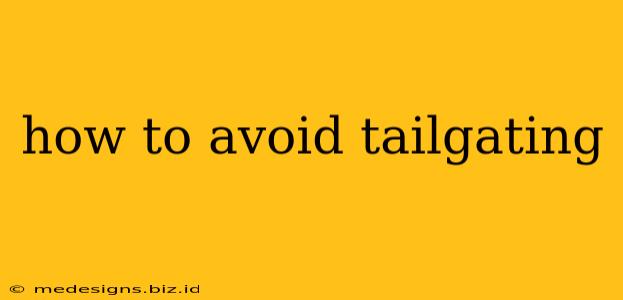Tailgating, that frustrating and dangerous practice of driving too closely behind another vehicle, is a major contributor to rear-end collisions. It's not just annoying; it's incredibly risky. This comprehensive guide will equip you with the knowledge and strategies to avoid tailgating, both as the driver being followed and the driver who might be tempted to tailgate.
Understanding the Dangers of Tailgating
Before diving into solutions, let's reinforce why avoiding tailgating is crucial:
- Reduced Reaction Time: Following too closely drastically reduces your reaction time if the car in front brakes suddenly. This significantly increases your chances of a collision.
- Increased Severity of Accidents: Rear-end collisions caused by tailgating often result in more severe injuries and damage compared to other types of accidents. The impact force is amplified by the speed and lack of braking distance.
- Increased Stress and Road Rage: Tailgating contributes to aggressive driving and road rage, creating a hostile environment for everyone on the road. It can escalate into dangerous confrontations.
- Legal Consequences: In many jurisdictions, tailgating is a traffic violation that can result in fines and points on your driving record.
How to Avoid Being Tailgated
While you can't control other drivers, you can take steps to minimize the likelihood of being tailgated:
- Maintain a Safe Following Distance: The 3-second rule is a good guideline. Choose a fixed object (like a signpost) and count three seconds after the car ahead passes it. If you pass the same object before you finish counting, you're following too closely.
- Drive Predictably: Smooth acceleration and braking help drivers behind you anticipate your movements, reducing the likelihood of them tailgating. Avoid sudden stops or lane changes without signaling.
- Use Your Signals: Clearly signaling your intentions – lane changes, turns, and braking – gives other drivers ample warning, preventing them from getting too close.
- Be Aware of Your Surroundings: Regularly check your mirrors to monitor the vehicles behind you. If you notice a car tailgating, adjust your driving accordingly (see below).
- Avoid Driving in the Left Lane (if not overtaking): Staying out of the left lane unless overtaking allows faster traffic to pass, reducing the chance of someone tailgating you out of impatience.
How to Avoid Tailgating Others
This is where personal responsibility comes in. Here’s how to avoid the dangerous habit of tailgating:
- Maintain a Safe Following Distance: This is the single most important step. Use the 3-second rule, and increase the distance in bad weather or heavy traffic.
- Adjust Your Speed: If traffic slows down, ease off the gas pedal gradually. Don't slam on the brakes.
- Be Patient: Traffic congestion is inevitable. Allowing yourself extra time for your journey will reduce the urge to tailgate.
- Manage Your Stress: Aggressive driving is often fueled by stress. Find ways to manage your stress levels before getting behind the wheel. Consider deep breathing exercises or listening to calming music.
- Respect Other Drivers: Remember that everyone on the road makes mistakes. Give other drivers the benefit of the doubt and avoid reacting aggressively to their errors.
What to Do If You're Being Tailgated
If a car is tailgating you, remain calm and try these strategies:
- Pull Over Safely: If possible and safe, pull over to the side of the road and let the tailgater pass.
- Increase Your Following Distance: Increase the distance between you and the car ahead to give yourself more reaction time.
- Avoid Sudden Braking: This could provoke an accident.
- Avoid Engaging: Don't make eye contact or engage with the tailgater.
- Call the Authorities (if necessary): If the tailgating becomes particularly aggressive or dangerous, call emergency services to report the situation.
Tailgating is preventable. By practicing safe driving habits and being mindful of your actions and those around you, we can create a safer and more respectful driving environment for everyone.
